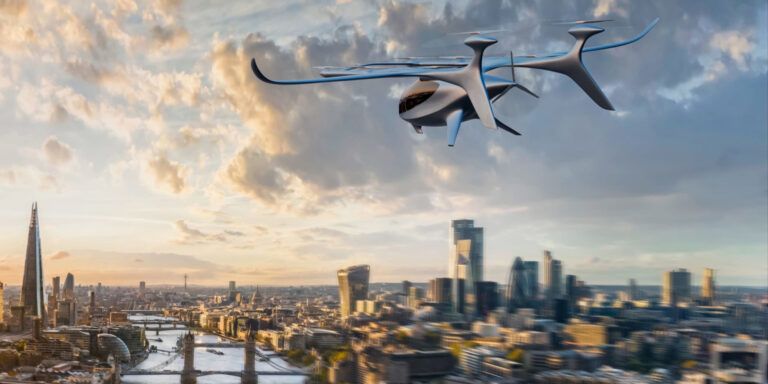The future of transport, whether goods or people, is in the sky. With a burgeoning population and great cost to ground-based infrastructure development, advanced air mobility has the potential to revolutionise the way we travel, from busy cities to remote communities. Plans laid out by the UK government aim to build a world-leading advanced air mobility sector by 2030; how realistic does this look?
The Government’s recent Future of Flight Action Plan sets out plans to implement advanced air mobility by 2030. By adopting this technology early, it hopes to place the UK at the cutting-edge of aviation in the coming decades, improving transportation connections and accessibility.
The plan centres on the development of advanced aviation technologies such as air taxis that use electric vertical take-off and landing (eVTOL) systems and Uncrewed Aircraft Systems (UAS), also known as drones. By integrating these into established aviation networks across the country, the plan lays a path to more eco-friendly, more available and faster short-trip air travel and urban delivery transport.
The Future of Flight Action Plan promises great development opportunities for the UK but with significant progress needed to close the gap in skills, infrastructure and tech, how might this plan materialise?
Drawing on automotive technology
The automotive sector has blazed a trail from which aerospace can glean wisdom. Autonomous navigation capabilities, in one form or another, have been deployed in cars for more than a decade, using sensors and sensor fusion technologies, such as radar, LiDAR and camera systems. These enable cars to assess and understand their environment, adjusting to live feedback. Similar sensor systems can be used in air taxis and drones, where exact navigation and hazard detection are vital for safe urban air-mobility usage.
The automotive sector has used sensor fusion and deep learning techniques to enhance the vehicle’s ability to make better decisions more reliably. By following this example, autonomous urban air vehicles would be better able to adapt to varying conditions during flight, manage complex flight paths and interact safely with other air traffic.
Supporting development with infrastructure
The Future of Flight Action Plan also discussed the need to upgrade air mobility infrastructure by creating a national network of vertiports. These dedicated hubs for drones and air-taxis are designed for vertical take-off and landing. They also offer charging and maintenance opportunities. These vertiports must be located in both rural and urban areas to maximise accessibility and effectiveness across the country.
Promisingly, the Civil Aviation Authority (CAA) carried out consultations on design proposals for vertiports at the UK’s existing aerodromes. While these consultations concluded in March 2024, the ensuing recommendations will take some time to be published and implemented. Nonetheless, this process will be important to meet the Government’s timeline laid out in the Future of Flight Action Plan.
An air traffic management system that can accommodate both manned and unmanned flights will be needed to support these vertiports. AI technology has a huge role to play in this management system, to provide the real-time data processing capability required to manage mixed-use airspace.
Cutting-edge tech for cutting-edge applications
Technologies such as AI and digital twins will provide the fuel to power the evolution needed over the next six years.
Sectors like manufacturing and cybersecurity are seeing the benefits of AI in improving process efficiency and system architecture. Huge volumes of data must be analysed to optimise flight routes for air taxis: weather information, traffic patterns and real-time situational monitoring. Using artificial intelligence to perform this analysis will maximise traffic efficiency and minimise the likelihood of congestion.
AI can also help automate processes, recommending adjustments in altitude and speed to maintain safe distances between aircraft and predict bottlenecks before they happen. Sensor data and maintenance logs, leveraged by AI, can inform predictive maintenance strategies to improve aircraft upkeep.
Real-world modelling, using digital twin technology, can supercharge the development and testing of UAS drones and air taxis. The simulated nature of digital twins can help keep costs down too. This approach can be used alongside different sensors on the actual aircraft too, enabling real-time monitoring and simulation.
These technologies boost troubleshooting and predictive maintenance capabilities. Both AI and digital twins can help to speed up development and improve the safety and efficiency of new urban air mobility solutions.
Regulations keeping pace with development
Standards are already in place in the UK to govern eVTOL-enabled air-mobility. The CAA has followed the European Aviation Safety Agency’s (EASA) regulations known as Special Conditions-VTOL (SC-VTOL), used to certify eVTOL aircraft. These rules aim to ensure high safety levels for the operation and manufacturing of eVTOL aircraft within the UK.
The CAA’s regulatory framework for UASs under UK regulation classifies them into categories with distinct safety, identification and operational requirements. It also describes specific duties for manufacturers, importers and distributors to ensure high safety standards and market compliance.
Up-skilling to meet projected demand
Just as state-of-the-art technology will enable this advance in UK aerospace operations, the country will need a new class of skilled professionals to implement it.
Training and education programmes will need to evolve to include engineering, aviation technology, cybersecurity and data analysis courses tailored to this industry. The objective must be greater than simply filling roles. To position the UK as a global leader in advanced air mobility, these workers should be encouraged and enabled to innovate and lead.
The Future of Flight Action Plan predicts that UAS and eVTOL systems could contribute up to £45 billion to the UK economy by 2030, if adopted on a widespread basis. This will come through productivity benefits and cost savings across various sectors from commerce to off-shore energy to public services. Additionally, the socioeconomic benefits of advanced air mobility could range between £1 billion and £2 billion annually by 2040, including reductions in costs.
To support the population, and associated economic growth that the UK is likely to experience in the coming decades, advanced air mobility technology, infrastructure and workforce will all need to be built. AI and digital twins will be essential in helping this progress materialise. If we can keep that development on course, we might all be taking air taxis and receiving drone deliveries a bit sooner than you think.
Jeff Hoyle is executive vice president of Aero, Space and Defence at Expleo, an engineering, technology and consulting services provider.





